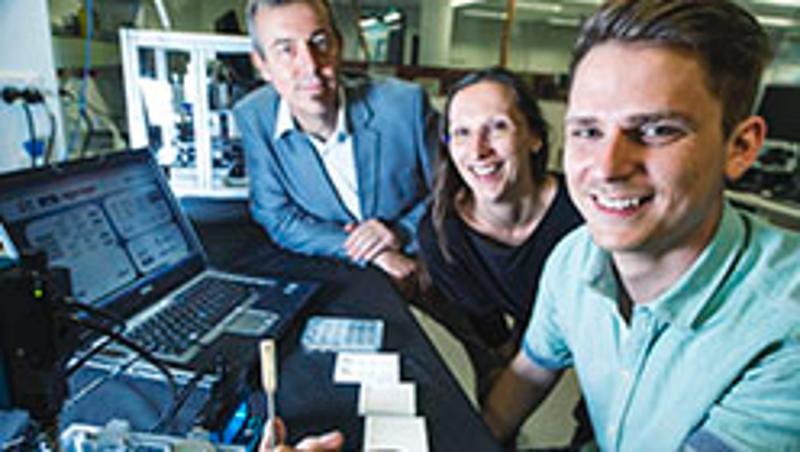
They look like small, translucent gems but these tiny ‘gel’ slivers hold the world of a patient’s tumour in microcosm ready for trials of anti-cancer drugs to find the best match between treatment and tumour.
The ‘gel’ is a new 3D printable material developed by QUT researchers that opens the way to rapid, personalised cancer treatment by enabling multiple, simultaneous tests to find the correct therapy to target a particular tumour.
Professor Dietmar W. Hutmacher from QUT’s Institute of Health and Biomedical Innovation said the new material was a gelatine-based hydrogel that mimicked human tissue.
The method for producing the gelatine-based hydrogel is published in the journal Nature Protocols.
“Hydrogel is a biomaterial used by thousands of researchers around the globe; gelatine is based on collagen, one of the most common tissues in the human body. We have modified the gelatine to engineer 3D tumour microenvironments,” Professor Hutmacher said.
“Our big breakthrough is we can produce this high-quality material on a very large scale inexpensively.
“It is highly reproducible which means we have been able to produce this hydrogel hundreds of times, not just once or twice in the lab, so researchers worldwide will be able to create it.”
Professor Hutmacher said the new hydrogel could be used as a ‘bioink’ to print 3D ‘microenvironments’ or models of a tumour to test different anti-cancer drugs.
“We will be able to use this hydrogel infused with tumour cells to quickly create a number of models of patient-specific tumours.
“Instead of the sometimes hit and miss chemotherapy that affects every cell in the body this will allow us to test different anti-cancer drugs and different combinations of them all at once so that we can pinpoint an individualised treatment that will hit only the cancer cells.
“It will cut the process of finding a personalised treatment for each patient down to a week or two.”
Because the hydrogel can be modified to mimic the firmness of cartilage or softness of breast tissue it can be used to create models for all types of cancer and also for research on stem cells and tissue engineering.
The IHBI research team includes Dr Daniela Loessner, Associate Professor Travis Klein and PhD student Christoph Meinert. The study, Functionalization, preparation and use of cell-laden gelatin methacryloyl-based hydrogels as modular tissue culture platforms was published this week.
The new hydrogel discovery is part of Biofabrication Research led by Professor Hutmacher at IHBI, which launched the world’s first Master of Biofabrication, a dual Australian and European master degree.
“We are seeking more students for the masters course at IHBI from all science and technology disciplines,” Professor Hutmacher says.
“Biofabrication is the future of medicine. It is a multidisciplinary area of research that requires an understanding of chemistry, physics, biology, medicine, robotics and computer science and we welcome graduates from any of these fields to apply for the master degree.”
International collaborators include Professor Ali Khademhosseini from Harvard University, and Associate Professor Ferry Melchels, who was a post-doctoral researcher at IHBI for three years on a Marie Curie Fellowship, now at the Heriot-Watt University in the UK.
Professor Ali Khademhosseini and Professor Hutmacher received funding from Harvard Club of Australia Foundation for this research through an Australia-Harvard Fellowship. This research was also funded by the National Health and Medical Research Council, Australian Research Council, National Breast Cancer Foundation and Queensland Cancer Council.
Media contact: Niki Widdowson, QUT Media, 07 3138 2999 or n.widdowson@qut.edu.au
After hours: Rose Trapnell, 0407 585 901, media@qut.edu.au.




